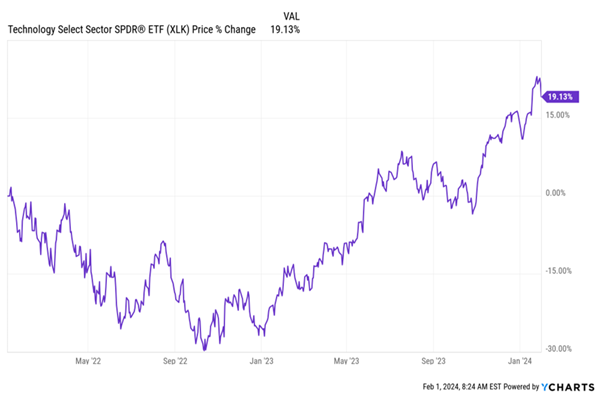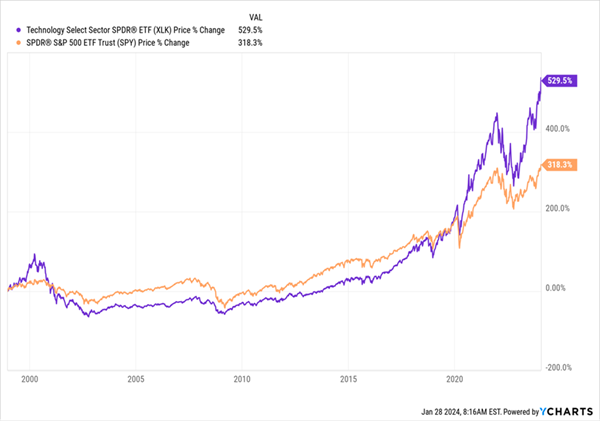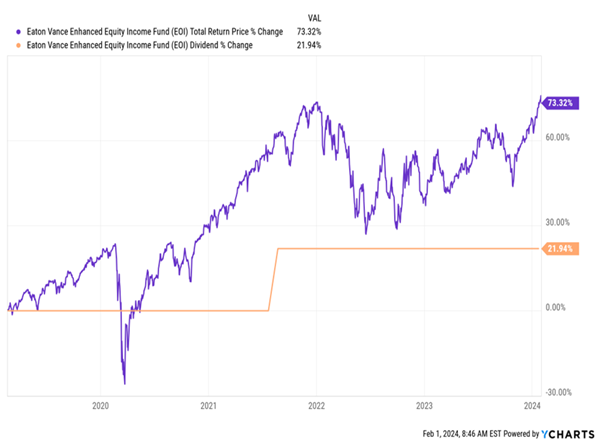2 Tech Funds With Huge Dividends (1 Is A Buy, 1 Is A “Wait And See”)
You probably know the Don Henley song “Dirty Laundry.” It was one of my favorite tunes in the 1980s. A criticism of media sensationalism, the repetitive chorus rang in my ears when I was much younger than I am today:
“Kick ’em when they’re up,
Kick ’em when they’re down.”
This aptly describes the nightly news of the 1980s and the financial press of the 2020s.
In early 2022, for example, Business Insider kicked tech stocks as they were going down: “Rising interest rates and expectations of strong economic growth and inflation are all key factors in the sell-off” the site wrote then, mixing up the good (“strong economic growth”) with the bad (“inflation”).
Tech stocks have posted strong gains since, rising over 19% in the roughly two years since, including the bear market of 2022:
Tech Defies Inflated Inflation Fears
Note that these gains aren’t just from the so-called “Magnificent Seven” that has become a meme lately: Microsoft (MSFT), Alphabet (GOOGL), Amazon.com (AMZN), Apple (AAPL), Meta Platforms (META), NVIDIA (NVDA) and Tesla (TSLA).
The tech-focused Technology Select Sector SPDR ETF (XLK), shown in the chart above, includes non-AI-focused companies like Broadcom (AVGO), Accenture (ACN), Cisco Systems (CSCO), Oracle Corp. (ORCL), Intuit (INTU), ServiceNow (NOW), Texas Instruments (TXN) and Palo Alto Networks (PANW).
You can see the breadth of tech companies here, from internet infrastructure to consulting to hardware and cybersecurity. This demonstrates an important point: tech is central to our lives, and it’ll only grow more so in the future. And betting against the future has never worked.
Still, the media isn’t giving up. Now Business Insider is telling us that tech is overvalued, a recession is coming and tech stocks are “doomed to suffer substantial losses.”
Kick them when they’re up, kick them when they’re down.
But we’re not buying it. Instead we’re investing in the future with tech stocks that hold their value and provide strong historical returns. A simple look at how XLK (in purple below) has done compared to the broader S&P 500 (in orange) since the ETF’s inception tells us all we need to know about tech’s long-term profitability:
Tech Is the Clear Winner
Note that XLK’s IPO was during the dot-com bubble of the late 1990s, so its outperformance comes despite the fact that it launched at the top of the market and at a time when it included a lot of overvalued, unprofitable companies.
So even if you think the tech sector of today is similarly full of overvalued companies, history tells us that we’d still be on the winning side of this investment in the long run.
Even so, XLK isn’t our go-to here, for a couple reasons. First, as potent a force as technology is, we also want to diversify, so we’re going to look to a more broad-based fund that holds both tech and non-tech names.
But more important, we want a stable cash flow to keep us secure in downturns like the early 2000s and 2022. XLK’s 0.7% yield is nowhere near good enough for that.
A Bargain “Tech + Diversification” Buy With a 7.7% Yield …
So instead, let’s consider a more diversified fund: the Eaton Vance Enhanced Equity Income Fund (EOI). This closed-end fund (CEF) sports the big tech names we’d expect among its top holdings, including most of the Magnificent Seven: Microsoft, Apple, Amazon.com, NVIDIA, Meta Platforms and Alphabet.
But EOI also goes beyond tech, with healthcare and consumer firms like Eli Lilly (LLY), Walmart (WMT) and Procter & Gamble (PG), thereby mixing defensive blue-chip reliability with a big investment in the future through its tech holdings.
Plus, EOI yields 7.7% today, which is more than 10 times what XLK pays. And its strategy of diversifying within and beyond tech has been paying off in terms of share price-growth—and growth for that rich 7.7% payout, too:
EOI Soars on High, and Rising Payouts Plus a Growing Share Price
That 73% return in just five years has meant EOI has been able to hike its already generous dividend. Conventional wisdom tells us double-digit payout growth like this isn’t possible with high yielders, but CEFs deliver that sweet high-yield-plus-payout-growth recipe all the time.
Finally, we’re getting a nice entry point, as EOI trades at a 3.4% discount to net asset value (NAV, or the value of the stocks in its underlying portfolio), well down from the near-par levels at which it traded during stocks’ rally in the latter part of 2023.
… And a “Pure-Play” Tech Fund to Put on Your Watch List
We’re not going to stop there, though, because I know many of our readers would prefer a more “pure play” tech fund. If that’s you, consider the Columbia Seligman Premium Technology Growth Fund (STK), which yields 5.7%. That’s a bit behind EOI’s payout, to be sure, but still far beyond the 0.7% you’d get from the index fund.
This one also holds the big-name techs you’d expect, along with more aggressive firms, like Dropbox (DBX), Teradyne (TER) and Applied Materials (AMAT).
STK boosts its income by selling options on a portion of its portfolio (25% to 90%, depending on market conditions). That’s a smart, low-risk way to generate extra cash to support the payout and generate special dividends, which the fund has done regularly, at year-end, in recent years.
The CEF also boasts a strong track record, with a 476% return in the last 10 years. Moreover, three-quarters of that came in cash, thanks to the fund’s high yield.
STK Returns Triple Digits, Mostly in Cash
The dividend more than compensates for that by providing $467 per month in payouts on a $100,000 investment versus $63 a month on the index fund, XLK. Moreover, STK’s lower yield versus EOI means it is reinvesting more of its portfolio returns in the market, increasing its chances of delivering bigger gains in the future.
The only thing to bear in mind here is that STK does trade at a 10% premium to NAV today, as opposed to the discount opportunity we have on EOI.
That’s not going to put us off, though. It simply means a good strategy here would be to move into EOI now and start collecting its higher payout while we wait for STK’s premium to drop below the 3.5% average at which it’s traded over the last five years.
Forget STK. These Tech CEFs Are FAR Cheaper (With FAR Bigger Yields)
Honestly, we don’t even have to wait because the portfolio of my CEF Insider service has both diversified and “pure-play” tech funds trading at MUCH more attractive valuations than STK—and with MUCH higher dividends, too!
To help you take full advantage of these bargain-priced high yielders, I’ve arranged to give you a no-risk 60-day trial to CEF Insider.
When you do, you’ll be taken to a page explaining, in full, my CEF investing strategy and giving you a FREE Special Report naming 4 of my top CEFs to buy now (average yield: 10.2%).
That Special Report comes with your 60-day no-risk trial to the service, including full access to the portfolio, including our top tech funds and a range of bond, real estate, blue-chip-stock and other funds, with yields topping out north of 12%!
This post originally appeared at Contrarian Outlook.
Category: ETFs









